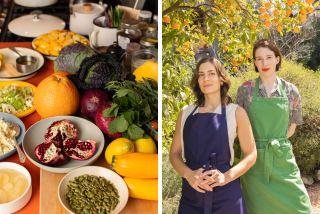Give them a hot minute
ASPARAGUS, fava beans, fiddleheads, ramps: These are the prizes of early spring. Amazing as they are, they’re just here for a fleeting time, and they beg a light touch, a deft response.
They demand a cooking technique as ephemeral as the season itself, one that preserves the intrinsic nature of the vegetable in all its sudden glory. To make the transition from raw and earth-clad to cooked and on your dinner plate as merciful as possible, the best thing to do is to blanch your spring bounty.
Julia Child called blanching “the great secret of French green-vegetable cookery,” and you soon see why. It’s a forthright, extremely easy method that requires only a pot of water, a healthy dose of salt (no, that’s not a contradiction in terms) and a brief moment of consideration. And the result is brilliant: The vegetables are preserved at their height of freshness, their rough-hewn nature tamed by the brief baptism, their flavor perfectly articulated, their color and crunch preserved. It works for baby carrots and turnips, as well as for the more fragile spring offerings.
The intense heat of the water cooks the vegetables so quickly that the freshness remains intact, while any raw harshness is softened.
Shock the vegetables in an ice water bath and the essence you’ve captured lasts for hours. Think of it as a momentary freeze-frame. Blanch a bundle of asparagus for five minutes, quickly douse it in cold water, and the glory of the asparagus can last all afternoon. Drain the bundle, pat dry, and either eat them right then or keep them in the refrigerator until you’re ready for them.
Tried and true tips
THERE are a few tricks to proper blanching. First, use a big pot of water. James Peterson, in his exhaustive and brilliant book “Vegetables,” suggests using at least three quarts of water per pound of vegetables. The idea is to keep the water as close to the boiling point as possible during the critical minutes when you’re adding the produce to the pot. Not enough water and everything will cool down too much; you want things to cook as quickly as possible.
Salting the water heavily (Peterson says about one tablespoon per quart of water) also ensures quick cooking, as salt raises the boiling point and also works to preserve the color. In “The French Laundry Cookbook,” Thomas Keller writes that when you’re blanching vegetables “the water should taste like the ocean.” And anyone worried about salt needn’t be, as almost all of it remains in the water. Keep the stove turned up as high as possible, but don’t succumb to the temptation of covering the pot. You want a quick boil, not a violent steam bath.
The third caveat is critical, as carry-over cooking can ruin a beautifully blanched vegetable in minutes. Have a bowl of ice water ready, or a running cold tap. As soon as the vegetables are done (five minutes, say, depending on the type and size of what you’re blanching), remove them from the pot and -- unless you have guests waiting with lifted forks and can eat them immediately -- plunge them into ice water. This stops the cooking instantly.
From the ice water, dry and refrigerate what you’ve blanched. Blanched vegetables can stay like this for hours, though after six or so, they’ll begin to wilt and discolor. If you want to use your vegetables cold, in a composed salad or under a splash of vinaigrette, you needn’t do anything else to them.
If you want to serve your vegetables warm, under a hollandaise, say, you will need to reheat them. This is what restaurants do, though remember that this is when you can inadvertently reduce your perfect emerald spears of new asparagus to a sodden, overcooked, gray-green mass.
Please resist the urge to throw the blanched vegetables back into a boiling pot or into a microwave. Instead, heat a few tablespoons of water to boiling in a saute pan and quickly toss in the vegetables. As soon as they’re hot, you’re done. Blot on a paper towel and serve them with their accompaniment. Or, after they’re heated through, add a trace of butter or olive oil into a new hot pan and toss them quickly -- if they’re already hot, they won’t become greasy, the way they inevitably would if you reheat them in butter from the start.
A critical juncture
IF you’re making a quick spring ragout, such as Deborah Madison’s, blanching becomes the critical transitional stage, enabling the spring vegetables to be cooked before they get to the dish itself. If asparagus is your pleasure, use kitchen string to tie it into a bundle; that keeps the tiny spears from getting too buffeted by the roiling water. A few minutes, then into an ice bath. Serve them simply with a vinaigrette, with a traditional hollandaise, or in a composed salad.
Or take ramps, wild leeks. They look like small scallions with unusually wide, flat leaves and are available in farmers markets right now. But not for long: David West of Clearwater Farms says he’s never seen them past mid-May. Plunge them into your pot and the result is a brilliant paean to spring; the perfect way to catch the savory glory of the slim, delicate onions. A rich, fruity vinaigrette is all they need.
Fiddleheads, which you can find only for the next few weeks, are the coiled part of a new fern -- usually an ostrich fern -- that hasn’t yet unfurled. Culled from forest beds and riverbanks in New England and along the California-Oregon border, they’re glorious served simply with butter and herbs or, for a breathtaking forest meal, with fresh morels. Just rinse them to remove stray dirt and the faint chaff from their edges, and blanch them for about five minutes. The heat cooks them, leavens their bitterness, but keeps a slight crunch. Dress them with melted butter and herbs and serve them, like a gift from the forest floor.
*
Fiddleheads with fresh herbs
Total time: 30 minutes
Servings: 4
Note: Look for fiddlehead ferns at Whole Foods Markets and soon at selected farmers markets.
Sea salt
1 pound fiddlehead ferns
2 tablespoons unsalted butter
1 tablespoon finely chopped parsley
1 tablespoon finely chopped chives
Freshly ground black pepper
1. Bring a large pot of water to a boil using 1 tablespoon salt per quart of water. Trim the ends of each fern and rub off the brown chaff from the edges under running water. Rinse thoroughly and drain.
2. Drop ferns into the boiling water and cook for 3 to 4 minutes. Scoop out and plunge into ice water. Drain and reserve.
3. Melt butter in a large saute pan over medium heat. Add ferns and cook for a few minutes just to heat through. Toss with herbs, salt and pepper to taste and serve immediately.
Each serving: 89 calories; 5 grams protein; 6 grams carbohydrates; 0 fiber; 6 grams fat; 4 grams saturated fat; 15 mg. cholesterol; 2 mg. sodium.
*
Young root-vegetable braise
Total time: 1 hour
Servings: 2 to 4
Note: Adapted from “Local Flavors: Cooking and Eating From America’s Farmers’ Markets,” by Deborah Madison, who suggests serving this with herb dumplings. It’s also a lovely side dish for a rack of lamb.
Sea salt
12 small turnips, peeled, stems trimmed to one-half inch
1 bunch radishes, stems trimmed to one-half inch
6 small carrots (3 to 4 inches long), peeled, stems trimmed to one-half inch
1 pound fava beans, shucked
2 tablespoons unsalted butter, divided
1bunch green onions, trimmed (use 2 to 3 inches of white and pale green part only) and sliced lengthwise
2 tablespoons finely chopped parsley
1 tablespoon finely chopped tarragon
1 tablespoon lemon juice
Freshly ground pepper
1. Bring a large pot of water to a boil over medium-high heat, adding 1 tablespoon of salt per quart of water. Slice the turnips and radishes in half if large; leave the smaller ones whole.
2. Blanch the turnips, radishes and carrots for 5 minutes, less if smaller, then lift them out of the simmering water and plunge them into an ice water bath. Drain, pat dry and set aside.
3. Bring the water back to a boil and add the fava beans; blanch 1 minute. Remove with a slotted spoon and place in the ice water bath. Reserve the cooking water. Pop the fava beans out of their skins and reserve the beans.
4. Melt 1 tablespoon of the butter in a 10-inch saute pan. Add the green onions and cook over medium heat for about 2 minutes, stirring frequently. Add one-half cup of the vegetable cooking water, the blanched vegetables, half of the parsley and tarragon and one-fourth teaspoon salt. Simmer until the vegetables are fully tender, about 10 minutes or until done. Add one-fourth cup cooking water as needed to maintain a small amount of sauce in the pan.
5. Add the fava beans, remaining butter and lemon juice. Increase the heat and swirl the pan back and forth until the butter has melted. Remove from the heat, add the rest of the parsley and tarragon, season with salt and pepper to taste and serve.
Each serving: 210 calories; 11 grams protein; 34 grams carbohydrates; 4 grams fiber; 7 grams fat; 4 grams saturated fat; 15 mg. cholesterol; 145 mg. sodium.
*
Ramps in walnut vinaigrette with orange zest
Total time: 45 minutes
Servings: 4
Note: Adapted from “Vegetables From Amaranth to Zucchini,” by Elizabeth Schneider. Look for ramps at farmers markets.
Sea salt
4 dozen ramps (about 1 pound)
1 teaspoon (optional for bread crumbs) plus 2 tablespoons olive oil
1/4 cup fresh bread crumbs, optional
1 1/2 teaspoons grated orange zest
1 1/2 tablespoons sherry vinegar
1 teaspoon Dijon mustard
2 tablespoons walnut oil
Salt
1. Bring a large pot of water, salted with 1 tablespoon salt per quart of water, to a boil. If the ramps are clean, trim the roots and rinse well. If they’re not clean, slip off the first layer of skin then trim the roots. Remove wilted leaves, if any. Rinse the ramps in several changes of water, swishing vigorously. If the ramps have bulbs, cut the leaves apart from stems where they begin to branch, leaving most of the red stem on bulbs. Young ramps will not have pronounced bulbs or red stems.
2. Place the whole young ramps (or bulbs) in the boiling salted water. Simmer until the thickest part can be pierced easily with a sharp knife, 2 to 4 minutes, or as size dictates. Lift the ramps or bulbs from the hot water and plunge into ice water, then drain and reserve.
3. Blanch the leaves (if using) in water for 30 seconds. Plunge them into ice water, then drain and reserve. If using whole young ramps, squeeze the moisture from them and coarsely chop half of them. If using bulbs, leave whole.
4. Optionally, heat 1 teaspoon olive oil in a small saute pan and add the bread crumbs. Lightly toast over low heat and set aside. Cool slightly then stir in the orange zest. If not using bread crumbs, reserve the orange zest for a later step.
5. Blend the vinegar, mustard and one-fourth teaspoon salt. Gradually add the walnut oil and the remaining 2 tablespoons olive oil, whisking to emulsify.
6. Arrange about 6 whole leaves or whole ramps on each of 4 serving plates. Stir several spoonfuls of dressing into the chopped ramps and spoon on next. If using bulbs, arrange them on the leaves. Drizzle with dressing. Sprinkle bread crumb-orange mixture or orange zest alone over top and serve immediately.
Each serving: 158 calories; 2 grams protein; 9 grams carbohydrates; 3 grams fiber; 14 grams fat; 2 grams saturated fat; 0 cholesterol; 50 mg. sodium.



